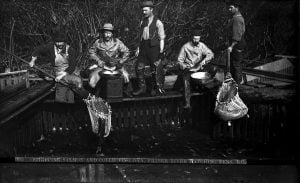Millions of hatchery-raised trout have been released into the wild over the last few decades in Nova Scotia, but new research shows the hatchery trout haven’t bred with the wild brook trout already present.
The Department of Fisheries and Oceans conducted a two-year study, which sampled 1,500 wild brook trout and two hundred hatchery trout in 12 Nova Scotia river systems.
Sarah Lehnert, research scientist with DFO, says the study was spurred by the declining populations of brook trout in Nova Scotia in recent decades.
“This species is important to the province, as it’s the primary sport fish in Nova Scotia,” says Lehnert.
About two million hatchery trout are released each year in the region. Larger fish are released in the spring specifically for anglers, and smaller fish are released in the fall that are meant to survive until the spring angling season. The initial concern in mixing the hatchery and wild populations was that hatchery fish genes make the trout well-suited for life in controlled environments, not in rivers. As such, fish raised in hatcheries aren’t as able to adapt to Nova Scotian climate conditions.
The results of the study showed that the two types of trout were still genetically distinct, and therefore hadn’t mixed their populations.
“This may indicate that the hatchery fish are being caught by anglers soon after they are released, which is good news, as this is one of the main objectives of the provincial hatchery program,” says Lehnert. “If any of these trout aren’t caught by anglers, then they are either not surviving or their offspring aren’t surviving. So overall, the genes of hatchery fish are not getting into the wild gene pool. This is good for the wild trout populations of Nova Scotia, because it means the genetic integrity of the populations remains intact.”
Lehnert says one exception to the results was found in the Margaree River, which is stocked with fish from a smaller local hatchery.
“In this river, the fish that are released seem to be surviving and potentially interbreeding with the wild population. This may be the exception because the hatchery and wild trout are very genetically similar, so the hatchery trout may be well adapted to the Margaree River,” says Lehnert.
According to Lehnert, the study’s research method and findings can be applied to any situation involving both captive and wild species, but research still needs to be done on a case-by-case basis.
“In many cases, releasing captive-raised animals is done to help the wild population, so it is important that we consider the impacts of this in order to protect the wild population. If the main goal is to rescue a population, it may be better to release animals that are genetically similar to the wild population, and this might help increase the chances that the captive-raised animal survives in the wild,” says Lehnert.
Lehnert is currently working to expand her study across eastern North America, exploring the evolutionary history of brook trout in the continent and to try to understand how trout are responding to climate change.





